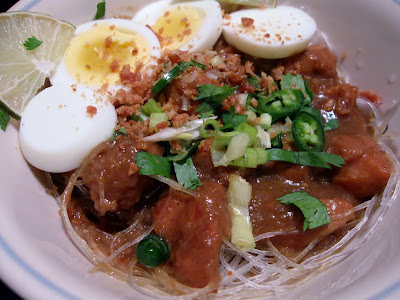The recipe calls for a large daikon, but I think the one I got in my share was more of a medium so I cut the other ingredients down by a third.
Ingredients:
2 Tablespoons rice vinegar
2/3 Tablespoon sugar
2/3 teaspoon salt
1 medium daikon, thinly sliced
1 medium shallot, thinly sliced [the original recipe calls for a small onion, but I think shallot is much nicer for raw applications.]
peanut oil for frying
6 cloves garlic, thinly sliced
1 1/2 Tablespoons peanuts
2/3 Tablespoon sesame seeds
2/3 teaspoon fish sauce
1 1/2 Tablespoons cilantro, chopped
1. Mix the vinegar,
 sugar and salt in a medium bowl until dissolved. Add daikon, toss to coat and chill for 15 minutes.
sugar and salt in a medium bowl until dissolved. Add daikon, toss to coat and chill for 15 minutes.2. Soak shallot in cold water for 5 minutes. Drain. [I don't know what this step accomplishes that a rinse wouldn't, but it wasn't any bother so I went along with it.]
3. Meanwhile, heat oil over medium heat in a small pan until shimmery. Add garlic and fry until golden brown. [This doesn't take long so have your draining set up ready, keep a close eye and remove the garlic quickly once it hits the right stage. I was distracted, burnt my garlic and had to resort to the pre-packaged sort.]
4. Drain the oil from
 the pan and add the peanuts. Toast until they brown and start to smell toasty. Throw in the sesame seeds briefly. Shortly after the seeds start popping remove them and the peanuts to a food processor and grind until fairly fine. [Again keep a close eye or you'll end up making peanut/sesame butter that'll be pretty tasty but won't be of any use for this recipe.]
the pan and add the peanuts. Toast until they brown and start to smell toasty. Throw in the sesame seeds briefly. Shortly after the seeds start popping remove them and the peanuts to a food processor and grind until fairly fine. [Again keep a close eye or you'll end up making peanut/sesame butter that'll be pretty tasty but won't be of any use for this recipe.]5. Remove the daikon from the brine and drain well. In a large bowl, mix the daikon and onion. Add garlic, peanuts and sesame seeds, then the fish sauce and cilantro. Toss well and serve with a Burmese curry.
To accomplish that last step, I made a simple Burmese chicken curry I found at asianonlinerecipes.com.
Ingredients:
1 large onion, roughly chopped
3 cloves garlic, squished
about an equal amount of ginger, chopped [the original recipe called for 5 centimeters of ginger. I don't really know how to interpret a linear measurement for something as irregularly shaped as ginger so I fell back on my default of using the same amount as I used of garlic.]
1 Tablespoon peanut oil
1/4 teaspoon belacan (Burmese shrimp paste) [There are a lot of types of shrimp paste and I only keep Chinese and Filipino on hand. Since belacan is fermented, Chinese is closer so I used that.]
2 chicken thighs, skinned, boned and cut into 1-2-inch pieces [Now that I look at it, this recipe doesn't call for cutting up the chicken thighs. Probably better not to, but I would remove the skin, I think.]
1/2 teaspoon salt
1 cup coconut milk
1/2 teaspoon chili powder
1/2 teaspoon tumeric
1. Add onion,
 garlic and ginger to a food processor (with a little water if necessary) and process until smooth.
garlic and ginger to a food processor (with a little water if necessary) and process until smooth.2. Heat oil over medium high heat in a medium saucepan until shimmery. Add onion mixture and shrimp paste. Cook 5 minutes until starting to brown.
3. Add chicken, turn heat down to medium and cook a few minutes until the chicken loses its pinkness and the onion starts seriously browning.
4. Add salt,
 coconut milk and spices. Bring to a boil, reduce heat to low, cover and simmer 30 minutes. Stir and scrape the bottom on the pan occasionally.
coconut milk and spices. Bring to a boil, reduce heat to low, cover and simmer 30 minutes. Stir and scrape the bottom on the pan occasionally.5. Remove the cover and cook for 15 minutes or so to reduce the sauce by around half.
Serve over vermicelli noodles.
I found the curry's flavor a bit dull so I added traditional Burmese condiments: cilantro, scallion, fresh chili pepper, fried garlic and hard boiled egg.

After its quick pickle, there's little left of the daikon's original mild bite, but it's not entirely lost. It balances against the sweetness of the sugar and the toastiness of the garlic, peanuts and sesame seeds. The salad is a lovely fresh and bright crispness against the heavy richness of the curry.

As this is the first Burmese curry I've made, and as I used the wrong shrimp paste, it's hard for me to judge, but, even heavily condimentated I find it rather flat (to the point where it needs a salad to contrast against, but maybe that's on purpose). The seasoning was rather simple, so maybe I'm missing a bunch of flavors from hard-to-find ingredients that were left out of the recipe. I'll have to do some investigation to learn more about Burmese cuisine. I did like the way the onion/coconut sauce browned as it cooked down. It's an effect I quite like in Indonesian curries I've made and there it's been quite flavorful. Maybe that's down to the galangal and kimiri nuts that usually go into that sort of dish.
Anyway, the salad was nice. It should go well with Thai or Vietnamese dishes too.
















